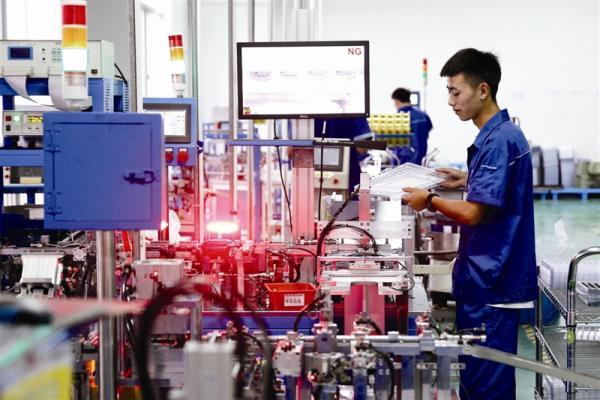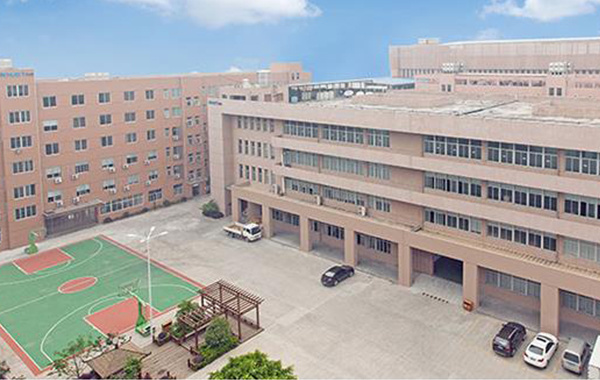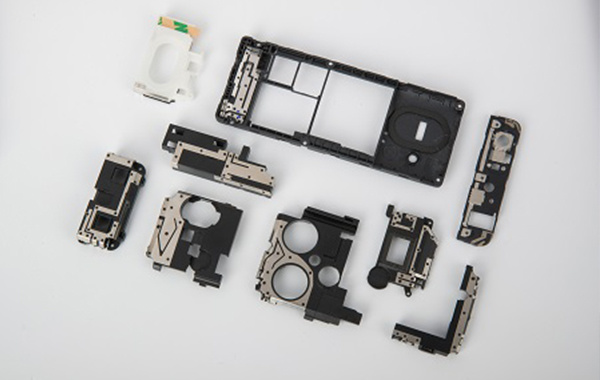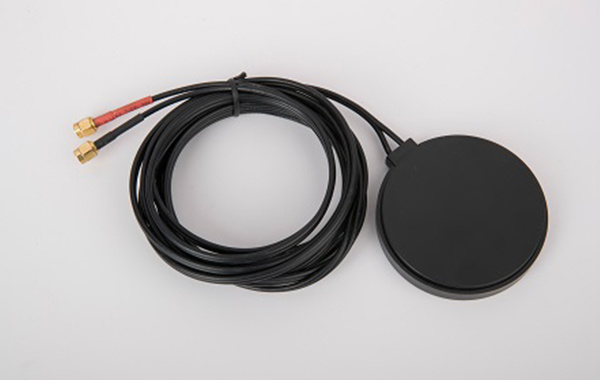Amazing! Global giants such as Huawei and Xiaomi are eyeing this company... (From: Toutiao)
Published Time:
2021-11-05 11:23
Source:
From chip antennas and FPC antennas to LDS antennas, each technological update has brought about an increase in antenna value. Today, Haitong Communications ships 150 million mobile phone antennas of various types annually, enough to equip tens of millions of mobile phones.

The production workshop of Zhejiang Haitong Communications Electronics Co., Ltd. is located in the Wenzhou Economic and Technological Development Zone.
Antennas, a technology invented in the late 19th century, have fundamentally changed the way humans transmit information and are now widely used in various communication fields, serving as a "key" to unlocking the information age.
In 2003, Zhejiang Haitong Communications Electronics Co., Ltd. (hereinafter referred to as "Haitong Communications"), formerly known as Yueqing Haitong Communications Electronics Co., Ltd., entered the communications industry. From an "outsider" back then, it has risen to become a leading enterprise in China's mobile phone antenna industry. Haitong Communications Chairman Li Fangyu said that consistent investment in technology and talent for over a decade has allowed them to persevere and establish a firm foothold in the industry.
Today, Haitong Communications produces over 100 million mobile phone antennas annually, providing antenna solutions or products to globally renowned mobile phone manufacturers such as Huawei, Xiaomi, Samsung, Lenovo, Motorola, TCL, Alcatel, TECNO, and Meizu, as well as automotive and drone manufacturers. It has become a communication enterprise capable of competing with listed companies such as XinTong Communications and Shuobode in the technological field.
The first microwave anechoic chamber used for testing was "rented".
For a smartphone, functions such as WiFi, GPS, calls, and network connectivity all rely on that tiny antenna.
An antenna is a component used to receive and transmit electromagnetic waves, serving as a fundamental component of wireless communication technology. Antennas have a wide range of applications, including mobile phones, smart wearables, tablets, laptops, drones, automobiles, and essentially wherever wireless communication is used.
Founded in Yueqing, before entering the antenna industry, Li Fangyu and his wife Jin Haiyan, also a founder, ran a metal parts manufacturing company, Haitong Industrial Electronics Co., Ltd., specializing in telephone switches and machined metal parts, some of which were used as shielding covers for telephones. Due to their business, they frequently interacted with clients in the communications industry.
“Back then, mobile phones weren't yet widespread, and Nokia dominated the mobile phone market; mobile phone antennas were all external antennas. We heard that the mobile phone antenna market was almost monopolized by American and European companies, and the prices were relatively high,” Li Fangyu saw a business opportunity in this. Although the antenna industry and metal parts were two completely different fields, and despite the risk, he resolutely ventured into this unfamiliar domain.
Starting from scratch, many difficulties faced Haitong Communications, a "newborn." First, there was a lack of personnel. Producing mobile phone antennas requires professionals with expertise in electromagnetic fields, microwave technology, and communications. Such talent was unavailable in Wenzhou, so Li Fangyu traveled to Suzhou and recruited a professional team from a local communication company.
Antenna performance testing requires a microwave anechoic chamber, primarily to test various indicators such as mobile phone radiation and signal strength. In 2003, an imported microwave anechoic chamber with testing equipment cost approximately 10 million RMB. Haitong Communications collaborated with Soochow University, leveraging the university's microwave anechoic chamber to establish a wireless business unit.
Haitong Communications started by manufacturing the contact strips for external antennas. That was the peak of the PHS (Personal Handy-phone System) era, when users sometimes needed to pull out the antenna to enhance signal reception. Haitong Communications' earliest clients included UTStarcom and China Orient Telecom.
National Layout: R&D Centers within 3 Kilometers of Clients
In 2007, the first-generation Apple iPhone was released, a year many consider the "year of the smartphone."
That year, Haitong Communications purchased an office building in Shenzhen, establishing its first microwave anechoic chamber and its first R&D center outside of Wenzhou. Subsequently, in 2011, 2014, and 2018, Haitong Communications established antenna R&D centers in Shanghai, Beijing, and Xi'an, respectively. Haitong Communications' production bases are located in the Wenzhou Economic and Technological Development Zone and Huizhou, Guangdong.
These four antenna R&D centers are equipped with leading domestic antenna design teams and advanced hardware and software, including multiple advanced near-field microwave anechoic chambers, DASY5 SAR&HAC laboratories, and NFC active testing laboratories. They can provide comprehensive antenna solutions for various mobile terminals such as mobile phones, automobiles, wireless routers, cordless phones, and POS machines.
“We primarily serve the consumer electronics industry, which is ever-changing, so our R&D centers need to be close to our clients for easy communication and feedback adjustments,” Jin Haiyan explained. Haitong Communications' R&D centers are generally located within 3 kilometers of clients, operating 24/7 for uninterrupted product testing and a rapid response system. They immediately understand client needs, reducing communication costs. Haitong Communications can provide basic solutions within 10 hours of receiving client requests.
Smartphone Evolution Presents New Challenges for Haitong Communications
If you were to take apart a phone today, many might not be able to find the antenna. Although still called an "antenna," the signal transmission carrier is rarely a "wire" anymore.
Jin Haiyan showed the reporter several mobile phone antennas produced by Haitong Communications, mainly contact strip antennas, FPC antennas (flexible printed circuit boards, made of polyimide or polyester film as a substrate, with high reliability, excellent flexibility, high wiring density, lightweight, thinness, and good bendability), and LDS antennas (laser-direct-structured antennas, formed by laser ablation onto a plastic substrate). Specifically, LDS antennas, by directly changing the physical properties of part of the phone's frame, have become part of the phone's casing. The casings of some full-metal phones are the antennas themselves.
From contact strip antennas, to FPC antennas, and then to LDS antennas, each technological update has increased the value of the antennas. Now, Haitong Communications' annual shipment of various mobile phone antennas reaches 150 million units, capable of equipping tens of millions of mobile phones.
On the other hand, the rapid advancement of smartphones has made the demands on mobile phone antennas more "stringent"—from external antennas to internal antennas; as phones become increasingly thinner, the space available for antennas is also becoming smaller. Simultaneously, the number of antennas required in a mobile phone is also increasing. In addition to 2G/3G antennas, WiFi antennas, Bluetooth antennas, and GPS antennas, 4G antennas and NFC antennas have been added. The increase in antenna types has led to increasing demands for antenna isolation, electromagnetic compatibility, precision, consistency, and reliability.
This presents new challenges to Haitong Communications' technology and R&D capabilities.
Relentless investment in R&D, with equipment value alone approaching 100 million
Speaking of R&D investment, Haitong Communications has not slackened in this area for more than 10 years. Technology is also the foundation of this Wenzhou enterprise's survival and development.
Li Fangyu revealed that Haitong Communications' annual R&D expenditure accounts for about 10% of its sales revenue. Currently, Haitong Communications has a R&D team of nearly 100 people, composed of doctors, masters, and antenna experts. The company holds 35 patented technologies, and many more technologies have not been declared publicly. At the end of 2016, the company was named one of the first batch of "hidden champions" enterprises in Zhejiang Province.
Statistics show that last year, only over 40 listed companies in China reached this proportion of 10%, while Huawei, known for its R&D investment, had a 14.9% R&D ratio in 2017. For a small and medium-sized enterprise like Haitong Communications, this level of investment is quite high.
“Our R&D investment is mainly in talent introduction and equipment. Now the value of the equipment is close to 100 million yuan,” said Li Fangyu.
For the talent the company needs, Haitong Communications uses various methods, such as equity incentives, to attract talent. At the same time, it keeps a close eye on relevant universities such as University of Electronic Science and Technology of China and Xidian University, recruiting outstanding graduates every year.
With talent, Haitong Communications has the confidence to extend to deeper and broader fields. In recent years, Haitong Communications has focused on wireless charging, 5G communication, and Beidou navigation. Since the Beidou system provided regional services in 2012, Haitong Communications has been producing supporting antennas for various Beidou navigation instrument terminals. This year, Haitong Communications has further cooperated with the Shanghai Beidou Navigation Platform Company to further participate in the Beidou industrial chain.
The upcoming 5G era is also a challenge and opportunity for Haitong Communications. Li Fangyu revealed that Haitong Communications' 5G antenna technology reserves have already been started. Now they need to wait for the completion of 5G infrastructure construction and, according to customer needs, launch mobile phone antenna products and mobile phone antenna design solutions that meet 5G transmission requirements.
Dialogue with Li Fangyu, Chairman of Haitong Communications Electronics Co., Ltd.
Reporter: Besides mobile phone antennas, what other products does Haitong Communications have?
Li Fangyu: Our products are mainly divided into three categories: antennas, connectors, and metal parts, including antennas for mobile phones, computers, and automobiles; shielding housings, SMT grounding, and radio frequency springs and other precision stamping parts; and communication connectors such as RJ and USB series products. The antenna product line is also rich, including mobile phone antennas, tablet antennas, and car antennas.
Reporter: Why has Haitong Communications attached importance to technological R&D from the beginning?
Li Fangyu: Antennas are an indispensable part of the smart terminal industry. As people's requirements for the "appearance" and user experience of smart terminals such as mobile phones and wearable devices become higher and higher, customers will also put forward various requirements for antenna manufacturers, especially since our current customers are high-end customers. Many of these requirements need to be solved by technicians. It can be said that without technology, it is difficult to survive in this industry.
Reporter: The 5G era is approaching. What preparations does Haitong Communications have?
Li Fangyu: 5G will bring great changes to our lives. For example, in terms of Internet access, the original high speed is a four-lane two-way road, and after 5G arrives, it will become an eight-lane two-way road. We started to prepare for 5G in 2017. 5G antennas cover more frequencies and have wider bandwidths. For ordinary people, the experience of using smart terminal devices will be better, but for antenna manufacturers like us, the skill difficulty is also higher.
Now, when we use mobile phones in some places, we encounter poor signal conditions. However, in the 5G era, the intelligence of the antenna itself will be enhanced. For example, if a mobile phone finds that the signal in its location is poor, it will have an intelligent enhancement function, or the base station will also enhance the signal for this mobile phone. These technical issues need to be researched and solved in the future.
Reporter: Besides technology, what else has contributed to Haitong Communications' success today?
Li Fangyu: We entered this industry in 2003. From a domestic perspective, we entered this field relatively early. After entering, Haitong Communications has always focused on this field. As the company's management is very focused, the direction of the company as a whole remains consistent. With more than ten years of accumulation, we have been able to achieve what we have today. Our company's philosophy is "integrity, gratitude," and we strive to provide the most comprehensive service to our customers, so our customer satisfaction has always been very high.
Reporter: What are Haitong Communications' plans for the future?
Li Fangyu: Haitong Communications is fortunate to have caught up with this round of development in the communications industry and seized the opportunity of the booming development of the communications electronics industry. Based on this, through focusing on technological R&D, strict requirements for product quality, and maintaining a high degree of sensitivity to changes in market demand, the company's operating revenue has continued to expand.
Ultimately, technological innovation is still the pillar of our future development. From the perspective of the Sino-US trade war, I think that as enterprises, we have become more aware of the importance of mastering technology. Next, Haitong Communications will continue to improve the antenna industry, and on the other hand, we have also started the R&D of automotive oxygen sensors, hoping to open up other fields.
Reporter's Notes
Accelerating High-Quality Development Requires Greater Emphasis on R&D
Haitong Communications is a very special enterprise in Wenzhou. It originated in Yueqing, a place known for its electrical appliances. But in Wenzhou, you can't find another company that engages in antenna R&D and production like it. In Li Fangyu's words, you can't find a second one in Zhejiang Province either. There are many such companies in Shanghai and Guangdong, where there are many mobile phone manufacturers, and antenna production companies are nearby to provide supporting services.
The special thing about Haitong Communications is its tireless investment in R&D. Founded in 2003, with continuous R&D investment of about 10% for 15 years, it is really not a small amount for a growing company. This shows the vision of the two founders of Haitong Communications—Li Fangyu and Jin Haiyan. Only companies willing to continuously invest in innovation can become part of the new engine of economic development in Wenzhou's future.
Corporate R&D investment is receiving increasing attention. This year's government work report's "main expected targets for the city's economic and social development" includes "R&D expenditure accounting for 2.1% of the regional GDP." In addition, several policies have been introduced to encourage enterprises to increase investment in technological innovation.
According to the "Wenzhou City's New "Double Increase" Three-Year Action Plan for Science and Technology Enterprises (2018-2020)" issued this year, Wenzhou City will implement the New "Double Increase" Three-Year Action Plan for Science and Technology Enterprises to accelerate the development of high-tech enterprises and technology-based small and medium-sized enterprises with both quantity and quality, further promoting the deep integration of industrial chains, innovation chains, capital chains, and talent chains, and providing strong support for building a modernized economic system. According to relevant data, in 2015, there were 700 high-tech enterprises in the city, reaching 827 in 2016, and 958 by the end of 2017. The Plan mentions that it will integrate various technological innovation resources, enhance the effect of policy support, improve the innovation and entrepreneurship ecosystem, and build a tiered cultivation mechanism for science and technology enterprises ("micro-growth, small-to-high, high-growth"). By 2020, it aims to strive for a cumulative number of more than 2,000 high-tech enterprises and more than 10,000 provincial-level technology-based small and medium-sized enterprises in the city.
In recent years, Wenzhou has put forward the slogan of "accelerating high-quality development." High quality is relative to the past "low, scattered, and disordered" industrial structure. It calls for new impetus for Wenzhou's development, expecting more Wenzhou enterprises to increase investment in technological innovation, become standard-setters in various industries, own core patented technologies, and stand firm in the increasingly complex and profound globalization, gaining more voice.
(Original title "Annual antenna production exceeds 100 million units, Huawei, Xiaomi and other world-renowned manufacturers have chosen this Wenzhou enterprise's products", author Lü Jinko. Editor Qi Xianghao)
Previous Page
Related News
Haitong Communications | What is 5G-A?
At the recently concluded 2024 Mobile World Congress, a new technology took center stage: 5G-A. What exactly is this technology, and how will its emergence change our lives? Let's delve into the mysteries of 5G-A.
Haitong Communications | So many antennas are running on a 5G phone
Mobile phone design is a holistic endeavor. To achieve faster and smoother communication performance, the overall design will undergo significant changes, starting with the antenna.
Haitong Communication | Excellent Connector Project Express Delivery
Introduction to Haitong Communication Connectors: Haitong Communication can independently design and manufacture high-quality RJ connector products that meet FCC-part68, IEEE802.3, and ANSIX3.263 standards. Haitong currently has integrated RJ products with filtering functions and RJ products without filtering functions. Haitong's RJ products support network applications of different speeds, the most common of which are: 10/100base-T, 1000base-T, 2.5G/5Gbase-T, 10Gbase-T. Some types of RJ products can simultaneously have
Haitong Communications | The Evolution of Mobile Phone Antennas
The mobile phone antenna is an important component of mobile phone communication. The earliest mobile phone antennas can be traced back to the early 1980s, and their development has gone through several stages.
Haitong Communication | Excellent FPC Antenna Project Express Delivery
FPC Antenna: 1. FPC generally refers to a flexible printed circuit board, which is made of polyimide or polyester film as a substrate and has high reliability and excellent flexibility. It is lightweight, thin, flexible, foldable, high-performance, and low-cost. Compared to other PCB antennas, ceramic antennas, and LDS antennas, FPC antennas offer higher cost-effectiveness.
Zhejiang Haitong Communications | Women's Day Charm on March 8th
Haitong Goddess Festival Activities
Haitong Communication's In-Vehicle IoT Solution for T-BOX Systems
Haitong Communication has launched a constantly improving and reliable in-vehicle T-BOX accessory solution in the fields of antennas, metal parts, communication interconnection interfaces, and plastic shells.
©2024 Zhejiang Haitong Communication Electronics Co., Ltd. www.300.cn SEO

















